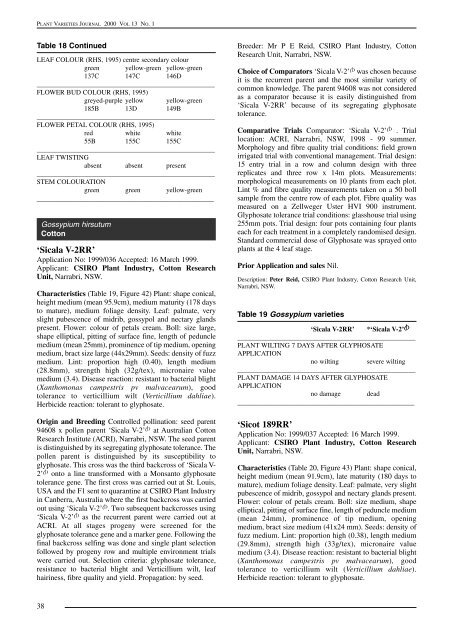53. Volume 13- Number 1 - IP Australia
53. Volume 13- Number 1 - IP Australia
53. Volume 13- Number 1 - IP Australia
Create successful ePaper yourself
Turn your PDF publications into a flip-book with our unique Google optimized e-Paper software.
PLANT VARIETIES JOURNAL 2000 VOL <strong>13</strong> NO. 1<br />
Table 18 Continued<br />
LEAF COLOUR (RHS, 1995) centre secondary colour<br />
green yellow-green yellow-green<br />
<strong>13</strong>7C 147C 146D<br />
____________________________________________________<br />
FLOWER BUD COLOUR (RHS, 1995)<br />
greyed-purple yellow yellow-green<br />
185B <strong>13</strong>D 149B<br />
____________________________________________________<br />
FLOWER PETAL COLOUR (RHS, 1995)<br />
red white white<br />
55B 155C 155C<br />
____________________________________________________<br />
LEAF TWISTING<br />
absent absent present<br />
____________________________________________________<br />
STEM COLOURATION<br />
green green yellow-green<br />
_______________________________________________<br />
Gossypium hirsutum<br />
Cotton<br />
‘Sicala V-2RR’<br />
Application No: 1999/036 Accepted: 16 March 1999.<br />
Applicant: CSIRO Plant Industry, Cotton Research<br />
Unit, Narrabri, NSW.<br />
Characteristics (Table 19, Figure 42) Plant: shape conical,<br />
height medium (mean 95.9cm), medium maturity (178 days<br />
to mature), medium foliage density. Leaf: palmate, very<br />
slight pubescence of midrib, gossypol and nectary glands<br />
present. Flower: colour of petals cream. Boll: size large,<br />
shape elliptical, pitting of surface fine, length of peduncle<br />
medium (mean 25mm), prominence of tip medium, opening<br />
medium, bract size large (44x29mm). Seeds: density of fuzz<br />
medium. Lint: proportion high (0.40), length medium<br />
(28.8mm), strength high (32g/tex), micronaire value<br />
medium (3.4). Disease reaction: resistant to bacterial blight<br />
(Xanthomonas campestris pv malvacearum), good<br />
tolerance to verticillium wilt (Verticillium dahliae).<br />
Herbicide reaction: tolerant to glyphosate.<br />
Origin and Breeding Controlled pollination: seed parent<br />
94608 x pollen parent ‘Sicala V-2’ A at <strong>Australia</strong>n Cotton<br />
Research Institute (ACRI), Narrabri, NSW. The seed parent<br />
is distinguished by its segregating glyphosate tolerance. The<br />
pollen parent is distinguished by its susceptibility to<br />
glyphosate. This cross was the third backcross of ‘Sicala V-<br />
2’ A onto a line transformed with a Monsanto glyphosate<br />
tolerance gene. The first cross was carried out at St. Louis,<br />
USA and the F1 sent to quarantine at CSIRO Plant Industry<br />
in Canberra, <strong>Australia</strong> where the first backcross was carried<br />
out using ‘Sicala V-2’ A . Two subsequent backcrosses using<br />
‘Sicala V-2’ A as the recurrent parent were carried out at<br />
ACRI. At all stages progeny were screened for the<br />
glyphosate tolerance gene and a marker gene. Following the<br />
final backcross selfing was done and single plant selection<br />
followed by progeny row and multiple environment trials<br />
were carried out. Selection criteria: glyphosate tolerance,<br />
resistance to bacterial blight and Verticillium wilt, leaf<br />
hairiness, fibre quality and yield. Propagation: by seed.<br />
Breeder: Mr P E Reid, CSIRO Plant Industry, Cotton<br />
Research Unit, Narrabri, NSW.<br />
Choice of Comparators ‘Sicala V-2’ A was chosen because<br />
it is the recurrent parent and the most similar variety of<br />
common knowledge. The parent 94608 was not considered<br />
as a comparator because it is easily distinguished from<br />
‘Sicala V-2RR’ because of its segregating glyphosate<br />
tolerance.<br />
Comparative Trials Comparator: ‘Sicala V-2’ A . Trial<br />
location: ACRI, Narrabri, NSW, 1998 - 99 summer.<br />
Morphology and fibre quality trial conditions: field grown<br />
irrigated trial with conventional management. Trial design:<br />
15 entry trial in a row and column design with three<br />
replicates and three row x 14m plots. Measurements:<br />
morphological measurements on 10 plants from each plot.<br />
Lint % and fibre quality measurements taken on a 50 boll<br />
sample from the centre row of each plot. Fibre quality was<br />
measured on a Zellweger Uster HVI 900 instrument.<br />
Glyphosate tolerance trial conditions: glasshouse trial using<br />
255mm pots. Trial design: four pots containing four plants<br />
each for each treatment in a completely randomised design.<br />
Standard commercial dose of Glyphosate was sprayed onto<br />
plants at the 4 leaf stage.<br />
Prior Application and sales Nil.<br />
Description: Peter Reid, CSIRO Plant Industry, Cotton Research Unit,<br />
Narrabri, NSW.<br />
Table 19 Gossypium varieties<br />
‘Sicala V-2RR’ *‘Sicala V-2’ A<br />
____________________________________________________<br />
PLANT WILTING 7 DAYS AFTER GLYPHOSATE<br />
APPLICATION<br />
no wilting severe wilting<br />
____________________________________________________<br />
PLANT DAMAGE 14 DAYS AFTER GLYPHOSATE<br />
APPLICATION<br />
no damage dead<br />
_______________________________________________<br />
‘Sicot 189RR’<br />
Application No: 1999/037 Accepted: 16 March 1999.<br />
Applicant: CSIRO Plant Industry, Cotton Research<br />
Unit, Narrabri, NSW.<br />
Characteristics (Table 20, Figure 43) Plant: shape conical,<br />
height medium (mean 91.9cm), late maturity (180 days to<br />
mature), medium foliage density. Leaf: palmate, very slight<br />
pubescence of midrib, gossypol and nectary glands present.<br />
Flower: colour of petals cream. Boll: size medium, shape<br />
elliptical, pitting of surface fine, length of peduncle medium<br />
(mean 24mm), prominence of tip medium, opening<br />
medium, bract size medium (41x24 mm). Seeds: density of<br />
fuzz medium. Lint: proportion high (0.38), length medium<br />
(29.8mm), strength high (33g/tex), micronaire value<br />
medium (3.4). Disease reaction: resistant to bacterial blight<br />
(Xanthomonas campestris pv malvacearum), good<br />
tolerance to verticillium wilt (Verticillium dahliae).<br />
Herbicide reaction: tolerant to glyphosate.<br />
38

















